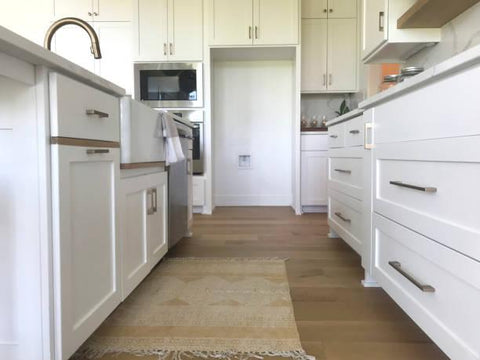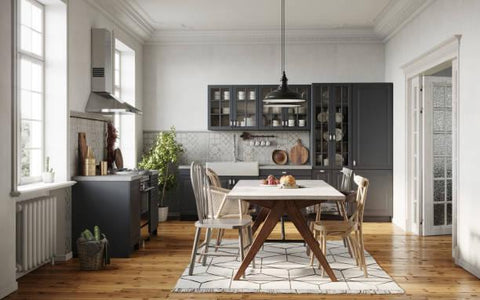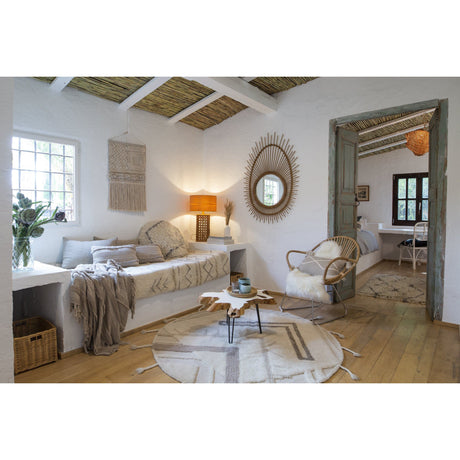Your kitchen can be a messy space. Spills, marks, dents, and stains make you ask yourself, “Is it ok to have kitchen area rugs?”
Elsewhere in your home, a rug can be a great complement to your furnishings and color scheme, bringing warmth and grouping furniture together to create a focal point in your room.
There’s some good news. You can bring that magic to your kitchen, despite the mess! Read on to find out how!
Kitchen Area Rugs – Tips and Tricks
1. Get the Right Size

When buying a rug for your kitchen, check the dimensions of your space to ensure you get the right size. For an area rug, most interior design experts recommend leaving about 6 inches to 2 feet of space around the border of the rug. This prevents your kitchen from looking cramped.
2. Get the Right Material
The type of material for your kitchen rug is important - it will determine how long it lasts and how easy it is to clean. Rugs made from recycled plastic (polypropylene) are the best for your kitchen. They’re easy to clean and stain-resistant.
Cotton rugs are more absorbent but still useful in the kitchen, as they can be machine washed. Rugs made from jute and wool can also be used but are not machine washable, and they’re harder to clean. Finally, make sure you get a rug underlay to prevent slips.
3. Short Pile Is Best

Whichever rug you choose, go for one with a low/short pile. High/deep pile rugs feel great under your feet but are harder to keep clean, and can get food and dirt stuck in them. In a high traffic messy area such as your kitchen, go for a short pile and make life easier for yourself.
4. Match the Style of Your Kitchen
A rug can complement the style of your kitchen if chosen correctly. Try to match the style of the rug to the color and theme of your kitchen.
For example, a Persian style rug with an elaborate design will better fit a rustic or classic style kitchen, whereas a rug with block shapes and color would better match a modern build. Darker colors are better at hiding stains and will look less faded after heavy use.
5. Placement Is Key

Think about where you want your rug to go and what purpose it serves. If you have an island counter in your kitchen, consider a long rug that will complement the space beside it perfectly. In open-plan settings, a rug can help create a distinction between the kitchen area and the rest of the room.
Area Rugs For Kitchen Table

Choosing the correct rug to match the décor of your kitchen can be difficult, but choosing one that combines form and function can be even harder. Here are a few tips to help you pick the right one.
Bigger Is Better
The best rug for a kitchen table must fit well to look good. If in doubt about the size, bigger is always better when it comes to table rugs – too small and your furniture will keep getting caught on the edges.
Make sure you select the right shape that matches not only your table but room as well – a good carpet and table combo before you’ve begun decorating a room can be the beginning of a room theme.
Thick or Thin?
Again, a good kitchen table rug must be a short pile or flat weave. They are easier to clean and maintain and will last longer in a high footfall area of your home.
A fluffy carpet may feel nice under your feet, but subject to the stresses of the kitchen table, it will be quickly worn down. As with a kitchen rug, natural, sustainable materials are best, especially those you can machine wash.
Bright or Dark?
Make sure you choose a color and pattern that matches your table set and your room. A rug with a striking pattern can imprint your character onto a room, and bright colors can complement an open plan and well-lit kitchen. However, beware of rugs that have exceptionally light colors and patterns for the kitchen table (especially if you have kids), as spots and stains will show up much more.
Make Your Rug Work For You
Make sure to combine form and function when choosing your rug. An underlay will prevent the chairs and table from slipping about, and prevent marks, dents, and scrapes underneath. It also enhances soundproofing when combined with a thinner pile carpet.
Kitchen Area Rugs for Hardwood Floors

A rug is a perfect complement to a wooden floor, combining ease of cleaning with warmth, color, and material contrast.
Choose the Best Material
When you select a rug for hardwood flooring, the type of material is not as important as the quality. Buying cheaper, synthetic material rugs can result in ‘bleed-through’ onto your flooring, and rougher materials can scratch and scuff wood over time.
It’s important to purchase a rug pad to prevent this. Your rug will last longer, and so will your flooring. Be sure to check what sort of pad you are purchasing - poor quality pads are coated with chemicals that can damage the flooring.
Match Your Flooring Type
Consider the type of flooring you have and match the rug to it. Darker floors can be complemented with colors such as beige, grey, or other pale colors with some patterning. A lighter floor can be matched with earthier colors and tones.
Clean First
Be sure to clean your floor before putting a rug down! This will prevent scuffing and scratches on the wood finish.
In Conclusion
Now you know how to select and match the best kind of rug for your kitchen. From pile type to placement, materials to aesthetics, you’re equipped to bring some homely warmth into your kitchen.
Remember though, sustainable and responsibly sourced rugs last longer than cheap synthetic ones. For safety, go for something with non-toxic dyes. Just like Lorena Canals, it provides hand-made kitchen area rugs, so nobody else will have the same one as you.



